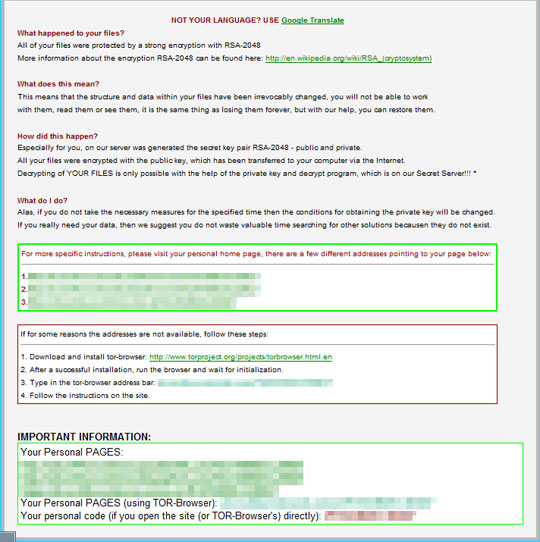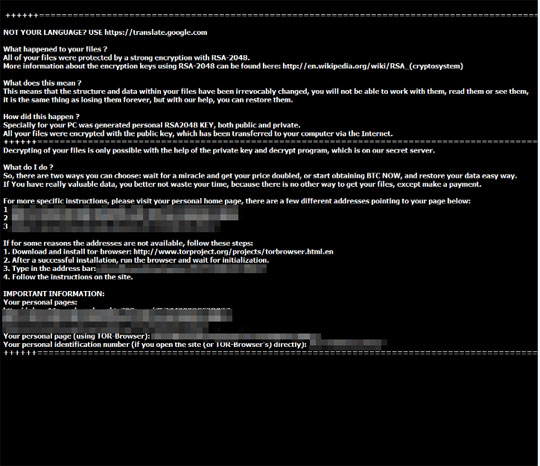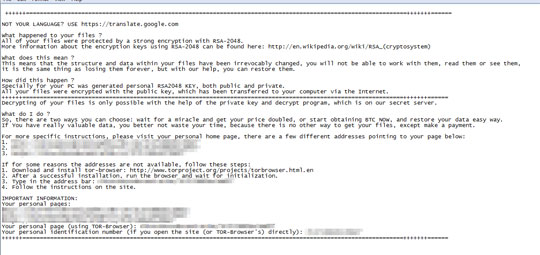Ransom.Win32.CRYPTESLA.KPNJ
Win32/Filecoder.TeslaCrypt.I trojan (NOD32); Ransom:Win32/Tescrypt (Microsoft)
Windows


Threat Type: Ransomware
Destructiveness: No
Encrypted: Yes
In the wild: Yes
OVERVIEW
Downloaded from the Internet
This Ransomware arrives on a system as a file dropped by other malware or as a file downloaded unknowingly by users when visiting malicious sites.
It executes then deletes itself afterward.
It connects to certain websites to send and receive information. It gathers information and reports it to its servers.
It encrypts files found in specific folders. It drops files as ransom note.
TECHNICAL DETAILS
327,168 bytes
EXE
Yes
25 Oct 2017
Connects to URLs/IPs, Displays message/message boxes, Encrypts files, Steals information
Arrival Details
This Ransomware arrives on a system as a file dropped by other malware or as a file downloaded unknowingly by users when visiting malicious sites.
Installation
This Ransomware drops the following copies of itself into the affected system and executes them:
- %Application Data%\{random string}-a.exe -> dropped copy
(Note: %Application Data% is the current user's Application Data folder, which is usually C:\Documents and Settings\{user name}\Application Data on Windows 2000(32-bit), XP, and Server 2003(32-bit), or C:\Users\{user name}\AppData\Roaming on Windows Vista, 7, 8, 8.1, 2008(64-bit), 2012(64-bit) and 10(64-bit).)
It drops the following files:
- %User Profile%\Documents\recover_file_{random string}.txt -> contains encoded data
(Note: %User Profile% is the current user's profile folder, which is usually C:\Documents and Settings\{user name} on Windows 2000(32-bit), XP, and Server 2003(32-bit), or C:\Users\{user name} on Windows Vista, 7, 8, 8.1, 2008(64-bit), 2012(64-bit) and 10(64-bit).)
It adds the following processes:
- bcdedit.exe /set {current} bootems off
- bcdedit.exe /set {current} advancedoptions off
- bcdedit.exe /set {current} optionsedit off
- bcdedit.exe /set {current} bootstatuspolicy IgnoreAllFailures
- bcdedit.exe /set {current} recoveryenabled off
- "%System%\vssadmin.exe" delete shadows /all /Quiet
- "%System%\NOTEPAD.EXE" %Desktop%\Howto_RESTORE_FILES.txt
- %Application Data%\{random string}-a.exe
- "%System%\cmd.exe" /c DEL {malware path}\{malware filename}.exe -> deletes original malware file
- "C:\Windows\system32\cmd.exe" /c DEL %Application Data%\{random string}-a.exe -> deletes dropped copy after execution
(Note: %System% is the Windows system folder, where it usually is C:\Windows\System32 on all Windows operating system versions.. %Desktop% is the current user's desktop, which is usually C:\Documents and Settings\{User Name}\Desktop on Windows 2000(32-bit), XP, and Server 2003(32-bit), or C:\Users\{user name}\Desktop on Windows Vista, 7, 8, 8.1, 2008(64-bit), 2012(64-bit) and 10(64-bit).. %Application Data% is the current user's Application Data folder, which is usually C:\Documents and Settings\{user name}\Application Data on Windows 2000(32-bit), XP, and Server 2003(32-bit), or C:\Users\{user name}\AppData\Roaming on Windows Vista, 7, 8, 8.1, 2008(64-bit), 2012(64-bit) and 10(64-bit).)
It executes then deletes itself afterward.
It adds the following mutexes to ensure that only one of its copies runs at any one time:
- 78456214324124
Autostart Technique
This Ransomware modifies the following registry entries to ensure it automatic execution at every system startup:
HKEY_CURRENT_USER\Software\Microsoft\
Windows\CurrentVersion\Run
Acronis = %Application Data%\{random string}-a.exe
Other System Modifications
This Ransomware adds the following registry entries:
HKEY_CURRENT_USER\Software\zsys
ID = {Instance ID}
HKEY_CURRENT_USER\Software\{Instance ID in hex}
data = {encoded data}
It modifies the following registry entries:
HKEY_LOCAL_MACHINE\SOFTWARE\Microsoft\
Windows\CurrentVersion\Policies\
System
EnableLinkedConnections = 1 -> to ensure it can find mapped network drives
Process Termination
This Ransomware terminates processes or services that contain any of the following strings if found running in the affected system's memory:
- askmg -> taskmgr
- rocex -> procexp
- egedi -> regedit
- sconfi -> msconfig
- cmd -> CMD
Other Details
This Ransomware adds the following registry keys:
HKEY_CURRENT_USER\Software\zsys
HKEY_CURRENT_USER\Software\{Instance ID in hex}
It connects to the following URL(s) to get the affected system's IP address:
- http://myexternalip.com/raw
It connects to the following website to send and receive information:
- http://{BLOCKED}a.com/misc.php
- http://{BLOCKED}rabailarsevillanas.com/wp-content/uploads/misc.php
- http://{BLOCKED}stiepel.com/tmp/misc.php
- http://{BLOCKED}den.com/sysmisc.php
- http://{BLOCKED}totalwellness.com/wp-content/uploads/misc.php
- http://{BLOCKED}k.com/misc.php
It encrypts files with the following extensions:
- .vpp_pc
- .r3d
- .ptx
- .pef
- .srw
- .x3f
- .der
- .cer
- .crt
- .pem
- .odt
- .ods
- .odp
- .odm
- .odc
- .odb
- .doc
- .docx
- .kdc
- .mef
- .mrwref
- .nrw
- .orf
- .raw
- .rwl
- .rw2
- .mdf
- .dbf
- .psd
- .pdd
- .eps
- .jpg
- .jpe
- .dng
- .3fr
- .arw
- .srf
- .sr2
- .bay
- .crw
- .cr2
- .dcr
- .ai
- .indd
- .cdr
- .erf
- .bar
- .hkx
- .raf
- .rofl
- .dba
- .db0
- .kdb
- .mpqge
- .vfs0
- .mcmeta
- .m2
- .lrf
- .ff
- .cfr
- .snx
- .lvl
- .arch00
- .ntl
- .fsh
- .itdb
- .itl
- .mddata
- .sidd
- .sidn
- .bkf
- .qic
- .bkp
- .bc7
- .bc6
- .pkpass
- .tax
- .gdb
- .qdf
- .t12
- .t13
- .ibank
- .sum
- .sie
- .zip
- .w3x
- .rim
- .psk
- .tor
- .vpk
- .iwd
- .kf
- .mlx
- .fpk
- .dazip
- .vtf
- .vcf
- .esm
- .blob
- .dmp
- .layout
- .menu
- .ncf
- .sid
- .sis
- .ztmp
- .vdf
- .mov
- .fos
- .sb
- .itm
- .wmo
- .itm
- .map
- .wmo
- .sb
- .svg
- .cas
- .gho
- .syncdb
- .mdbackup
- .hkdb
- .hplg
- .hvpl
- .icxs
- .docm
- .wps
- .xls
- .xlsx
- .xlsm
- .xlsb
- .xlk
- .ppt
- .pptx
- .pptm
- .mdb
- .accdb
- .pst
- .dwg
- .xf
- .dxg
- .wpd
- .rtf
- .wb2
- .pfx
- .p12
- .p7b
- .p7c
- .txt
- .jpeg
- .png
- .rb
- .css
- .js
- .flv
- .m3u
- .py
- .desc
- .xxx
- .wotreplay
- wallet
- .big
- .pak
- .rgss3a
- .epk
- .bik
- .slm
- .lbf
- .sav
- .re4
- .apk
- .bsa
- .ltx
- .forge
- .asset
- .litemod
- .iwi
- .das
- .upk
- .d3dbsp
- .csv
- .wmv
- .avi
- .wma
- .m4a
- .rar
- .7z
- .mp4
- .sql
It gathers the following information and reports it to its servers:
- Callback Function ("Ping" for initial request or "Crypted" after Encrypting)
- IP Address
- Operating System Version
- Malware Version
- Machine-specific Installation ID
- Domain Name Used
- RSA Key
- Bitcoin Address
- ECDH Global Recovery Key
- Part of the malware image file checksum (Used as ID)
Ransomware Routine
This Ransomware encrypts files found in the following folders:
- Fixed Drive
- Removable Drive
- Remote Drive
It avoids encrypting files with the following strings in their file path:
- recove
- .vvv
It avoids encrypting files found in the following folders:
- %Windows%
- %Program Files%
- %ProgramData%
(Note: %Windows% is the Windows folder, where it usually is C:\Windows on all Windows operating system versions.. %Program Files% is the default Program Files folder, usually C:\Program Files in Windows 2000(32-bit), Server 2003(32-bit), XP, Vista(64-bit), 7, 8, 8.1, 2008(64-bit), 2012(64-bit) and 10(64-bit) , or C:\Program Files (x86) in Windows XP(64-bit), Vista(64-bit), 7(64-bit), 8(64-bit), 8.1(64-bit), 2008(64-bit), 2012(64-bit) and 10(64-bit).. %ProgramData% is a version of the Program Files folder where any user on a multi-user computer can make changes to programs. This contains application data for all users. This is usually C:\ProgramData on Windows Vista, 7, 8, 8.1, 2008(64-bit), 2012(64-bit) and 10(64-bit), or C:\Documents and Settings\All Users on Windows Server 2003(32-bit), 2000(32-bit) and XP.)
It appends the following extension to the file name of the encrypted files:
- .vvv
It drops the following file(s) as ransom note:
- %Desktop%\Howto_RESTORE_FILES.html and {encrypted directory}\how_recover+{random string}.html

- %Desktop%\Howto_RESTORE_FILES.bmp

- %Desktop%\Howto_RESTORE_FILES.txt and {encrypted directory}\how_recover+{random string}.txt

SOLUTION
9.800
16.346.04
12 Nov 2020
16.347.00
13 Nov 2020
Step 1
Trend Micro Predictive Machine Learning detects and blocks malware at the first sign of its existence, before it executes on your system. When enabled, your Trend Micro product detects this malware under the following machine learning name:
- BKDR.Win32.TRX.XXPE002FF019
Step 2
Before doing any scans, Windows 7, Windows 8, Windows 8.1, and Windows 10 users must disable System Restore to allow full scanning of their computers.
Step 3
Note that not all files, folders, and registry keys and entries are installed on your computer during this malware's/spyware's/grayware's execution. This may be due to incomplete installation or other operating system conditions. If you do not find the same files/folders/registry information, please proceed to the next step.
Step 4
Restart in Safe Mode
Step 5
Delete this registry value
Important: Editing the Windows Registry incorrectly can lead to irreversible system malfunction. Please do this step only if you know how or you can ask assistance from your system administrator. Else, check this Microsoft article first before modifying your computer's registry.
- In HKEY_CURRENT_USER\Software\zsys
- ID = {Instance ID values}
- ID = {Instance ID values}
- In HKEY_CURRENT_USER\Software\{Instance ID in hex}
- data = {encoded data}
- data = {encoded data}
- In HKEY_CURRENT_USER\Software\Microsoft\Windows\CurrentVersion\Run
- Acronis = %Application Data%\{random string}-a.exe
- Acronis = %Application Data%\{random string}-a.exe
Step 6
Delete this registry key
Important: Editing the Windows Registry incorrectly can lead to irreversible system malfunction. Please do this step only if you know how or you can ask assistance from your system administrator. Else, check this Microsoft article first before modifying your computer's registry.
- HKEY_CURRENT_USER\Software\zsys
- HKEY_CURRENT_USER\Software\{Instance ID in hex}
Step 7
Search and delete this file
- %Application Data%\{random string}-a.exe
- %User Profile%\Documents\recover_file_{random string}.txt{encrypted directory}\how_recover+{random string}.html
- {encrypted directory}\how_recover+{random string}.txt
- %Desktop%\Howto_RESTORE_FILES.txt
- %Desktop%\Howto_RESTORE_FILES.html
- %Desktop%\Howto_RESTORE_FILES.bmp
Step 8
Restart in normal mode and scan your computer with your Trend Micro product for files detected as Ransom.Win32.CRYPTESLA.KPNJ. If the detected files have already been cleaned, deleted, or quarantined by your Trend Micro product, no further step is required. You may opt to simply delete the quarantined files. Please check this Knowledge Base page for more information.
Step 9
Restore encrypted files from backup.
Did this description help? Tell us how we did.


